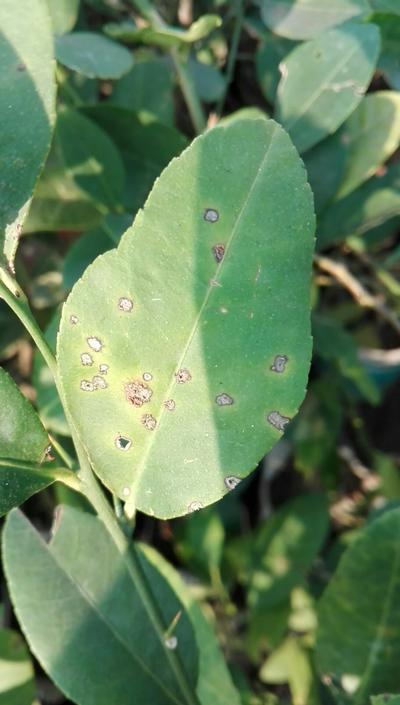Septoria Spot
Septoria citri
Fungus
In a Nutshell
- Small light-tan puts with narrow green margin on fruits.
- Turning reddish-brown.
- Raised, blister-like spits with yellow halo on leaves.
- Centers of leaf spots wither and turn pale brown.
- Lower tree part defoliates.
Can also be found in
Symptoms
On fruit, small, depressions or pits (1–2 mm diameter) appear, that extend no deeper than the rind. Pits are initially light tan with a narrow green margin, turning reddish brown as the fruit matures. Lesions may coalesce to form large irregular brown to black sunken areas. Closely grouped black specks can form within the lesions, representing the fruiting bodies of the fungus. Badly infected fruit quickly develop a characteristic smell and fall prematurely. Leaf symptoms appear as raised, blister-like black spots (1–4 mm diameter) surrounded by a yellow halo. Over time, the centers of the spots turn necrotic and pale brown. Under favorable conditions, the disease may cause severe leaf drop in the lower portion of the tree. As the leaves drop, the lesions turn dark brown and develop dark margins. Small black fruiting bodies form inside the lesions.
Recommendations

Organic Control
Organic fungicides based on copper and zinc sulfate effectively decimate Septoria citri. They should be applied prior to winter rains and, if necessary, secondary applications during the winter and early spring are recommended.

Chemical Control
Always consider an integrated approach with preventive measures together with biological treatments if available. Apply copper fungicides prior to autumn rainfall for an effective disease control. Products containing azoxystrobin combined with copper compounds also show satisfying control results. Sprays should be applied prior to winter rains and, if necessary, secondary applications during the winter and early spring are recommended.
What caused it?
The fungus survives on infected twigs, in dead wood and leaves and in the leaf litter on the ground. Spores are spread to healthy leaves and fruit by splashing water. Infection occurs when the fruit is still green in late summer or autumn after cool, damp weather. The fungus remains dormant in the fruit until symptoms develop 5–6 months later as the fruit ripens, usually following a period of cold windy weather. Septoria spot is generally more severe during years of higher than normal rainfall. Low or rapidly changing temperatures are thought to predispose citrus tissue to the disease.
Preventive Measures
- Plant varieties that are resistant or tolerant and have fewer thorns.
- Prune the trees so as to improve air circulation.
- Avoid overhead irrigation to prevent disease spread by water splashes.
- If possible, apply measures to protect the orchard from frost.
- Collect and destroy fallen leaves and fruits.
- Monitor the orchard regularly for signs of the disease.
- Prune trees regularly, especially infected branches or dead parts.
- Harvest fruits early.



